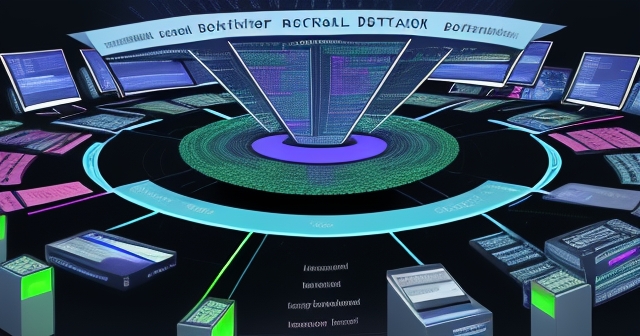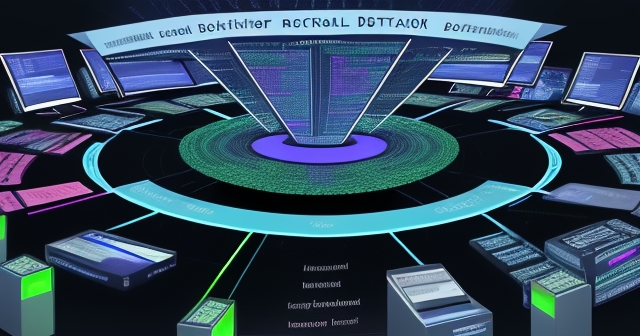Understanding DLT: How Distributed Ledgers Are Reshaping Trust and Transactions for Investors
Welcome to a discussion about a technology that’s fundamentally changing how we think about recording information, executing transactions, and building trust in the digital age. You’ve likely heard terms like “blockchain” associated with cryptocurrencies, but today, we’re diving deeper into the broader concept: Distributed Ledger Technology (DLT). For us as investors and traders, understanding DLT isn’t just about the latest buzzword; it’s about recognizing the potential shifts in the very infrastructure that underpins markets, assets, and financial systems.

Think about all the records you interact with daily – bank statements, ownership deeds, transaction histories. Traditionally, these records live in centralized databases, controlled by a single entity like a bank, government, or company. But what if there was a way to share and update these records simultaneously across a network of participants, with no single point of control? That’s the promise of DLT.
We’re going to explore exactly what DLT is, how it operates, why it’s different from traditional systems, and perhaps most importantly for you, where its impact is already being felt and where it might lead in the financial world and beyond. Are you ready to look under the hood of this potentially revolutionary technology?
Key points to consider:
- DLT can operate without a central authority, thus fostering trust among participants.
- It is crucial to understand how DLT differentiates itself from traditional databases.
- The implications of DLT extend across various sectors, not just finance.
What is DLT? A Decentralized Revolution in Record-Keeping
At its core, a Distributed Ledger Technology (DLT) is a digital system for recording transactions and data across multiple locations, devices, or participants simultaneously. Unlike a traditional ledger, which might be a physical book in an ancient marketplace or a centralized database server in a modern bank, a distributed ledger doesn’t reside in one place or under the sole control of one authority.
Instead, a DLT involves a database that is replicated and shared across a network of independent computers, often called nodes. Each of these nodes holds an identical copy of the ledger. When a transaction or data update occurs, it’s not just sent to a central server; it’s broadcast across the network. For the update to be added to the ledger, the nodes on the network must somehow agree that it’s valid and accurate.

This move from centralized control to decentralized distribution is a paradigm shift. It means that the integrity and security of the ledger depend on the network as a whole, rather than relying solely on the security measures and trustworthiness of a single entity. It’s like moving from a single, guarded vault for all community records to every member of the community having a copy of the ledger and agreeing on every new entry before it becomes official for everyone.
| Traditional Ledger | Distributed Ledger Technology (DLT) |
|---|---|
| Centralized database controlled by one entity. | Decentralized database shared across multiple nodes. |
| Single point of failure. | Redundant copies across a network of nodes. |
| Manual updates and reconciliations. | Automated, real-time updates with consensus. |
The concept of ledgers has evolved dramatically over history. From physical scrolls and accounting books, we moved to digitized versions stored in centralized databases. This brought efficiency but maintained the reliance on intermediaries and single points of control. DLT represents the next logical, yet revolutionary, step, leveraging cryptography and distributed computing to enable dynamic, shared, and potentially immutable records that can be accessed and validated by multiple parties simultaneously.
How DLT Works: Nodes, Consensus, and Cryptographic Security
To truly grasp DLT, we need to understand the fundamental components that make it function. It’s a sophisticated interplay of networked computers, agreement protocols, and advanced mathematics.
First, there are the nodes. These are the computers that make up the DLT network. They can be servers, desktops, or even mobile devices, depending on the specific DLT implementation. Each active node typically maintains a complete or partial replica of the entire distributed ledger. This redundancy is key to DLT’s resilience; if one node fails or is attacked, the ledger’s integrity is preserved by the other nodes.
Next is the crucial concept of Consensus. Since there’s no central authority deciding what the correct state of the ledger is or which transactions are valid, the network of nodes must collectively agree on the truth. This agreement is achieved through consensus mechanisms (also called consensus algorithms). Different DLTs use different mechanisms (like Proof-of-Work, Proof-of-Stake, Federated Byzantine Fault Tolerance, etc.), but the goal is the same: to ensure that all validating nodes eventually agree on the chronological order and validity of transactions and achieve a single, agreed-upon version of the ledger that is shared across the network. This process prevents double-spending and ensures data integrity in a trustless environment.

Finally, Cryptography is the bedrock of DLT security. Cryptographic techniques, such as hashing and digital signatures, are used to link data entries securely, verify the authenticity of participants, and ensure the integrity and privacy of the data. Each transaction or block of data is cryptographically linked to the previous one, creating a chain or verifiable history. Digital signatures, created using private and public keys, allow participants to prove ownership of assets or identities without revealing sensitive information and ensure that transactions are signed by the legitimate party. This cryptographic binding is what makes data stored on many DLTs, especially public ones, incredibly difficult to alter once recorded – contributing to the characteristic of immutability.
Imagine a digital lock (cryptography) placed on each piece of data, where only the right key can open it, and changing anything would break the lock visibly to everyone. Combined with multiple copies (nodes) and a requirement for everyone to agree on the lock’s status (consensus), you get a system far more transparent and tamper-evident than traditional centralized databases.
DLT vs. Blockchain: Understanding the Distinction
The terms DLT and Blockchain are often used interchangeably, especially in popular media, but it’s important to understand that they are not the same thing. Blockchain is a specific *type* of Distributed Ledger Technology.
Think of DLT as the broader category – the family of technologies for decentralized record-keeping. Blockchain is one prominent member of that family, like Bitcoin or Ethereum. What makes a blockchain a blockchain?
- Data Structure: Data is organized into blocks, and these blocks are linked together in a chronological chain using cryptographic hashes. Each block contains a hash of the previous block, making it exceptionally difficult to alter past data without invalidating subsequent blocks and being detected by the network.
- Immutability: Blockchains are typically designed to be highly, if not entirely, immutable once data is added and confirmed by consensus.
- Transparency (often): Many well-known blockchains are public and permissionless, meaning anyone can join the network and view the transaction history (though participants may be pseudonymous).
So, what about other DLTs that aren’t blockchains? These are often variations that might use different data structures or network models:
- Different Data Structures: Some DLTs might use a Directed Acyclic Graph (DAG) structure instead of a chain of blocks (like IOTA’s Tangle). These structures can offer different advantages, potentially in scalability or transaction fees.
- Network Permissions: Not all DLTs are public and permissionless like Bitcoin. Many enterprise-focused DLTs are permissioned, meaning participants must be invited or approved to join the network and potentially have varying levels of access or roles (e.g., only certain entities can validate transactions). Hyperledger Fabric is a well-known example of a permissioned DLT.
The key takeaway is this: All blockchains are distributed ledgers, but not all distributed ledgers are blockchains. Understanding this distinction is crucial as you explore different applications of the technology, especially in enterprise or private settings where permissioned models are often preferred.
| DLT Features | Blockchain Specific Features |
|---|---|
| Decentralized system with multiple nodes. | Structure organized in blocks linked together in a chain. |
| Ability to allow various consensus algorithms. | Immutability relies on block confirmation through consensus. |
| Can utilize different data models (graph, etc.). | Primarily relies on the chain structure for integrity. |
Benefits of Embracing DLT: Security, Transparency, and Efficiency
Why are organizations, including major financial institutions, investing time and resources into exploring and implementing DLT? The technology offers several compelling advantages over traditional centralized systems, particularly concerning security, transparency, and efficiency.
- Enhanced Security and Resilience: By distributing copies of the ledger across a network of nodes, DLT eliminates the single point of failure inherent in centralized databases. This decentralized architecture makes the system far more resilient against cyberattacks, system outages, or malicious tampering. To compromise the ledger, an attacker would theoretically need to gain control of a significant portion of the network’s nodes, which is orders of magnitude more difficult than attacking a single server.
- Increased Transparency (Configurable): Depending on its design (public vs. permissioned), a DLT can offer unprecedented transparency. In a public DLT, anyone can view transactions, creating an open and auditable record. In permissioned DLTs used by businesses, transparency can be selectively granted to authorized participants, allowing them to see only the data relevant to them, while still providing a shared, verifiable record. This shared visibility significantly reduces the need for time-consuming and costly manual audits and reconciliation processes between different parties.
- Improved Efficiency and Speed: By automating processes through consensus mechanisms and enabling near real-time data sharing across participants, DLT can drastically improve efficiency and speed. Transactions can potentially be settled faster, data can be shared instantly, and processes that previously required intermediaries to verify and reconcile information can be streamlined or eliminated entirely. This is particularly impactful in areas like cross-border payments and complex supply chains.
- Reduced Costs: Increased efficiency often translates to reduced costs. By minimizing or removing intermediaries, automating processes with smart contracts, and reducing the need for extensive manual reconciliation, DLT can lower operational expenses. The “cost of trust” is reduced because trust is built into the protocol through cryptography and consensus, rather than requiring expensive third-party verification services.
- Immutability and Data Integrity: As discussed, the cryptographic linking of data entries makes DLTs, particularly blockchains, highly resistant to tampering. Once data is recorded and agreed upon by the network, altering it is virtually impossible without consensus from the majority of participants. This provides a high degree of data integrity and an unalterable audit trail.
These benefits paint a picture of systems that are not only more robust and secure but also more open and efficient, potentially disrupting established ways of doing business and managing value. For us as investors, understanding these advantages helps us evaluate how DLT might impact the companies and markets we interact with.
| Benefits of DLT | Description |
|---|---|
| Security | Decentralized control reduces risks of attacks. |
| Transparency | Public visibility or selective access to records, depending on permissions. |
| Efficiency | Quicker settlements and reduced need for intermediaries. |
| Cost Reduction | Lower operational costs from automated processes. |
| Data Integrity | Immutable records verified by the network consensus. |
DLT Across Industries: Transformative Use Cases
While DLT gained initial fame with cryptocurrencies like Bitcoin, its potential applications extend far beyond digital currencies. Companies and organizations across numerous sectors are actively exploring or implementing DLT solutions to solve real-world problems. Let’s look at some key areas, focusing on those most relevant to the financial world and beyond.
Financial Services: This is arguably the industry with the most significant DLT activity outside of crypto. Major banks and financial institutions are investigating DLT for various use cases:
- Payments: Enabling faster, cheaper, and more transparent cross-border payments and remittances, potentially bypassing traditional correspondent banking networks.
- Trade Finance: Using smart contracts on DLTs to automate and streamline complex trade finance processes involving multiple parties and documents.
- Asset Tokenization: Representing real-world or digital assets (like real estate, art, securities, or even company shares) as digital tokens on a DLT. This can potentially make assets more liquid, divisible, and easier to trade and manage. Discussions around tokenizing financial assets are gaining significant traction.
- Know Your Customer (KYC) and Digital Identity: Using DLT to create secure, shareable digital identities that individuals or companies can control, potentially streamlining KYC processes across different institutions.
- Post-Trade Settlement: One of the most complex areas. Exploring DLT to shorten settlement cycles (moving from T+2 to T+1 or even T+0 – instantaneous settlement) for securities and other financial instruments. While challenging, this could reduce counterparty risk and free up capital. Institutions like DTCC have explored DLT options, though widespread adoption faces hurdles.
- Smart Contracts: Self-executing contracts where the terms of the agreement are written directly into code on the DLT. Once predefined conditions are met, the contract automatically executes (e.g., releasing funds when goods are confirmed delivered). This has applications in derivatives, insurance, and automated escrows.

We see institutions like JP Morgan (with its Onyx platform), Deutsche Bank, Citi, BNY Mellon, and Morgan Stanley actively investing or experimenting with DLT for various applications, indicating serious industry focus.
Supply Chain Management: DLT can bring unprecedented transparency and traceability to complex supply chains. By creating a shared, immutable record of a product’s journey – from raw material to consumer – DLT can help:
- Prevent fraud and counterfeiting.
- Verify provenance and ethical sourcing.
- Improve tracking and logistics efficiency.
- Automate payments based on delivery milestones using smart contracts.
Fujitsu’s work with the Rice Exchange is an example of DLT being used to enhance transparency and trust in commodity trading.
Other Sectors: DLT is also being explored in:
- Healthcare: Securely sharing patient records or managing clinical trial data.
- Aerospace & Defense: Tracking components, ensuring maintenance logs are accurate, enhancing cybersecurity, and managing complex contractual relationships (as seen with the AIA’s ADDC consortium aiming for a Minimum Viable Ecosystem).
- Identity Management: Beyond KYC, creating self-sovereign digital identities.
- Voting: Developing secure, transparent, and verifiable digital voting systems.
- Intellectual Property Management: Tracking ownership and usage rights.
As investors, observing these use cases helps us identify potential growth areas, understand risks, and see how traditional industries are being transformed by technological innovation.
Navigating the Hurdles: Challenges to Widespread DLT Adoption
Despite its compelling potential, DLT is not a magic bullet, and its path to widespread adoption, especially in established enterprise environments, is fraught with challenges. It’s crucial to have a realistic view of these hurdles.
- Scalability: Many early DLT designs, particularly public blockchains, face challenges in handling a high volume of transactions quickly and cheaply compared to centralized systems like Visa or Mastercard. While newer DLTs and scaling solutions are emerging, this remains a significant technical hurdle for enterprise adoption.
- Complexity: DLT is a complex technology requiring specialized expertise to design, implement, and maintain. Integrating DLT solutions with existing legacy systems in large organizations is a non-trivial task.
- Interoperability: As different DLT platforms and networks emerge (e.g., one bank uses Hyperledger, another uses Ethereum for tokenization), ensuring they can communicate and interact seamlessly (interoperability) is a major challenge. Without standards, different DLTs risk becoming isolated silos.
- Regulatory Uncertainty: The regulatory landscape for DLT and digital assets is still evolving globally. Lack of clear regulations can create uncertainty for businesses considering adopting the technology on a large scale. Regulators are often cautious, exploring through sandboxes (like in the UK) but also imposing strict requirements.
- Governance: Decentralized governance models on public DLTs can be slow and contentious. For permissioned DLTs, defining clear governance frameworks among consortium members is essential but can be complex to establish and maintain.
- Data Privacy: While some DLTs aim for transparency, privacy is critical for many enterprise use cases (e.g., sensitive customer data, proprietary business information). Designing DLT solutions that balance transparency with necessary privacy is challenging.
- Energy Consumption (for some DLTs): Proof-of-Work based DLTs (like Bitcoin) consume significant amounts of energy, which raises environmental concerns and can be a barrier for some organizations. Alternative consensus mechanisms address this, but adoption varies.
- Resistance to Change: Perhaps one of the biggest hurdles is simply overcoming inertia and resistance within large organizations with deeply entrenched processes and infrastructure built around centralized models. Replacing or augmenting these systems requires significant investment, cultural shifts, and trust in a new paradigm.
We’ve seen instances where promising DLT projects have faced setbacks or outright failures, such as the delays and eventual cancellation of the ASX’s (Australian Securities Exchange) project to replace its CHESS clearing and settlement system with a DLT-based solution. These aren’t necessarily death knells for DLT, but they highlight the significant technical, operational, and organizational challenges involved in implementing the technology at scale in critical infrastructure.
Similarly, initiatives like DTCC’s offering of a DLT option for CDS trades initially saw low uptake, underscoring that simply offering a DLT solution isn’t enough; the ecosystem needs to be ready, and the value proposition must be compelling enough to drive fundamental changes in how participants operate.
Acknowledging these challenges provides a balanced perspective. DLT is a powerful tool, but like any complex technology, its successful implementation requires careful planning, collaboration, and an understanding of its limitations.
The Regulatory Landscape and Standards Development
As DLT matures and moves from experimental labs into real-world applications, especially in regulated industries like finance, the role of regulators and the development of industry standards become increasingly critical. This is an area you, as an investor, should watch, as regulatory clarity and standardization can significantly impact the adoption rate and stability of DLT-based systems.
Regulatory bodies worldwide are grappling with how to oversee DLT. Approaches vary, from creating “sandboxes” that allow companies to experiment with DLT in a controlled environment (like the UK’s FCA sandbox) to developing specific licenses and regulations for digital assets and DLT platforms. Key concerns for regulators often include consumer protection, market integrity, financial stability, anti-money laundering (AML), and counter-terrorism financing (CFT).
The lack of globally consistent regulations is a challenge for businesses operating across borders. However, there is increasing dialogue and collaboration between regulators internationally to develop common frameworks and approaches.
Equally important is the development of standards. For DLT to achieve widespread adoption and interoperability, industry-wide standards are needed for areas like:
- Data formats: How information is structured and shared on ledgers.
- Identity and access management: How participants are identified and authorized.
- Consensus mechanisms: Establishing best practices or common approaches for different use cases.
- Interoperability protocols: Enabling different DLT networks to interact and exchange data or assets.
- Digital asset identifiers: Like ISINs (International Securities Identification Numbers) for traditional securities, establishing standards for identifying tokenized assets is crucial for market infrastructure and regulatory reporting (Deutsche Bank and others are actively involved in this).
Industry consortia and initiatives, often involving a mix of financial institutions, technology providers, and regulators, are actively working on developing these standards. Progress in this area is a strong indicator of DLT’s potential to move from niche applications to becoming a fundamental part of global financial and commercial infrastructure.
While the regulatory path may seem slow or uncertain at times, ongoing engagement from governments and industry leaders is a positive sign, suggesting a desire to responsibly integrate DLT into the existing ecosystem rather than simply dismissing it.
DLT Use Cases for Investors and Traders: What This Means for You
How does all this information about DLT translate into practical relevance for you as an investor or trader? While you might not be running a DLT node yourself, the technology’s impact on markets and assets could directly affect your investment opportunities, trading strategies, and the efficiency of your transactions.
- New Asset Classes: DLT enables the tokenization of assets. This means that illiquid assets (like real estate or fine art) could become tradable in smaller units on a DLT platform. Publicly traded securities could also be issued and traded as tokens, potentially allowing for 24/7 trading and faster settlement. Understanding tokenization is key to recognizing potential new investment opportunities.
- Faster Settlement: The move towards T+1 or T+0 settlement in financial markets, facilitated by DLT, could impact trading strategies, especially those involving short-term positions or high-frequency trading, by reducing counterparty risk and capital lockup times.
- Increased Market Transparency: In markets where DLT is implemented for things like trade finance or supply chain tracking, investors might gain access to more granular, verifiable data about companies or assets, potentially improving due diligence and valuation analysis.
- Smart Contracts and Automated Investments: While still evolving, smart contracts could potentially be used to automate aspects of investing, such as executing trades based on predefined conditions, managing derivatives, or even automating dividend payments or corporate actions for tokenized securities.
- Understanding Digital Assets: Even if you only trade cryptocurrencies, understanding the underlying DLT (often blockchain) provides crucial context about how these assets are created, secured, and transferred.

DLT isn’t just about cryptocurrencies; it’s about building a new digital infrastructure for value exchange and record-keeping. As this infrastructure develops, it will inevitably change the landscape of financial markets, presenting both opportunities and requiring new forms of understanding.
EEAT and DLT: Why Trust Matters in Decentralized Systems
The principles of EEAT (Experience, Expertise, Authoritativeness, Trustworthiness) are vital for evaluating information, and they are also deeply relevant to understanding Distributed Ledger Technology itself. Ironically, a technology designed to reduce the need for *interpersonal* trust by building trust into the protocol still relies on EEAT at various levels.
How does DLT embody or relate to EEAT?
- Experience & Expertise: The development and implementation of DLT require significant technical experience and expertise from engineers, cryptographers, and domain specialists (e.g., finance professionals for financial DLTs). The “experience” of the network itself, built over time through validated transactions, contributes to its robustness. For you, evaluating a DLT-based project requires understanding the experience and expertise of the team behind it.
- Authoritativeness: While there’s no single central authority for the ledger itself (in permissionless DLTs), the *rules* of the network (the protocol, consensus mechanism) act as the authority. In permissioned DLTs, designated participants or consortium members hold authority over network governance and access. For investors, the authority of the network’s consensus mechanism and the governance structure of a specific DLT implementation are key factors in its perceived legitimacy and stability.
- Trustworthiness: DLT is fundamentally designed to be trustworthy in terms of data integrity and transaction validity *due to* its technical properties – cryptography, consensus, and decentralization. You don’t need to trust a single entity; you trust the protocol and the collective validation of the network. However, trustworthiness still applies to the *developers* of the DLT, the *entities* using it for a specific application, and the *auditors* verifying its implementation. A DLT system is only as trustworthy as its design, implementation, and the integrity of the participants running it (especially in permissioned systems).
When you evaluate an investment opportunity involving DLT, whether it’s a cryptocurrency, a tokenized asset, or a company building DLT solutions, you should apply EEAT principles. Look at the team’s experience, their expertise in the relevant domain and DLT technology, the perceived authority of the project or platform, and the overall trustworthiness demonstrated through transparent practices, audits, and adherence to standards (where they exist). DLT provides powerful tools for building trust in data, but discerning trustworthy DLT *applications* still requires critical evaluation.
Conclusion: What DLT Means for Your Investing Journey Ahead
We’ve journeyed from the basic definition of Distributed Ledger Technology to its intricate workings, its distinction from blockchain, its widespread applications across industries (with a focus on finance), and the significant hurdles it must overcome. We also touched upon how EEAT principles are woven into the fabric of DLT’s design and evaluation.
DLT is not just a niche technology for cryptocurrencies; it represents a fundamental evolution in how we can manage information and value in a digital world. For you, the investor and trader, DLT and its applications could reshape markets by:
- Introducing new, potentially more liquid and accessible asset classes through tokenization.
- Increasing efficiency and reducing risk in trading and settlement processes.
- Providing greater transparency in certain market segments or supply chains.
- Powering innovative financial instruments and automated agreements via smart contracts.
While the journey towards widespread DLT adoption, particularly in complex established systems like global financial markets, is ongoing and faces significant challenges, the potential benefits are too large for major players to ignore. Ongoing experimentation, increasing regulatory engagement, and collaborative efforts to develop standards suggest that DLT will continue to evolve and play an increasingly important role.
As you navigate the investment landscape, staying informed about DLT, its progress, and its specific applications within sectors you invest in will provide you with a deeper understanding of the underlying infrastructure and potential future trends. DLT is building the railways for a new digital economy, and understanding how they work is crucial for anyone looking to travel confidently into the future of finance and beyond.
what is a distributed ledgerFAQ
Q:What are distributed ledgers?
A:Distributed ledgers are digital systems for recording transactions and data that are shared across multiple locations and maintained by multiple participants simultaneously.
Q:What are the primary benefits of DLT?
A:The primary benefits of DLT include enhanced security, increased transparency, improved efficiency, reduced costs, and data integrity.
Q:Are all DLTs blockchains?
A:No, while all blockchains are types of distributed ledgers, not all distributed ledgers are blockchains. DLT encompasses various technologies beyond just blockchain.
